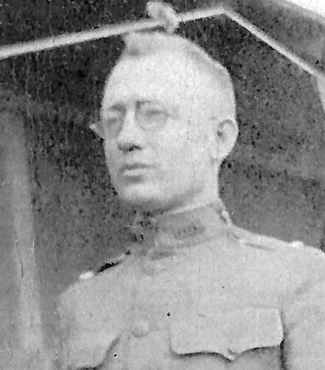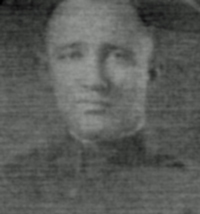
134th Infantry Regiment Website
"All Hell Can't Stop Us"

 |
134th Infantry Regiment Website"All Hell Can't Stop Us" |
 |

Captain (Doctor) Otto L. H. Hine received the Distinguished Service Cross for extraordinary heroism in action while serving with the Medical Detachment, 139th Infantry Regiment, 35th Division, at Chaudron Farm, France, during World War I.
A native of Oklahoma, Captain Hine's family moved from Oklahoma City to Muskogee in 1911, where he graduated from Central High School. He then went to Dental School in Kansas City, Missouri and after graduation returned to Muskogee, Oklahoma to start a dental practice. When the United States declared war on Germany on April 6, 1917, Dr. Hine volunteered for military service in the U. S. Army ten days later.
He was assigned to the Dental Reserves, with the rank of First Lieutenant, and was soon sent overseas to France. He served in several hospitals behind the trenches in France, and then with the Medical Detachment, 139th Infantry Regiment, 35th Infantry Division.
On September 29, 1918, First Lieutenant Hine followed the advancing 139th Infantry into "No Man's Land" during the Meuse Argonne Offensive. His job was to supervise a Field Aid Station at the front line near Chaudron Farm in the Argonne region. The Aid Station was soon filled with 94 patients. Here wounded soldiers received basic treatment before being sent to hospitals behind the front lines.
The 139th Infantry was taking heavy enemy fire, to include artillery with mustard gas. The Aid Station was informed that the 139th Infantry was going to withdraw, leaving the Aid Station out in front of the new line of defense and only 25 infantrymen to protect the Aid Station. As the withdrawal began, the Aid Station became the focus of German artillery. Until it could be evacuated, it would be exposed and vulnerable in the "No Man's Land" between the 139th Infantry and German forces.
At 0200 hours on September 30, 1918, at great personal risk, First
Lieutenant Hine made his way back to the new line of defense of the 139th
Infantry to report that the Aid Station was still in the middle of the fighting.
He requested artillery fire from the 129th Field Artillery to prevent the
Germans from overrunning the Aid Station.
Upon returning to the Aid Station, First Lieutenant Hine started the evacuation of the wounded, with the 129th Field Artillery firing their rounds to cover the evacuation. The artillery barrage lasted nine hours. With only seven litters to carry those who could not walk, Hine and his men at the Aid Station worked for hours under the cover of night as German artillery rained down on them. By the next day, all 94 wounded soldiers were safely evacuated back to the 139th Infantry lines. First Lieutenant Hine had to be treated at the new Aid Station for having breathed mustard gas while he worked to put gas masks on the wounded.
His words tell the story of his request for artillery support to protect him in the evacuation of his patients. "At the 70th Brigade headquarters I met an Artillery Lieutenant and he gave me the promise of a barrage over the Aid Station and across the road about 25 - 50 yards in front of it. The barrage was to start a 0430 on 30 September. I left the Observation Post at Baulny and returned to the Farm (the Aid Station) and withdrew the infantry protection just as the first shells of the barrage whistled over. The barrage continued until about 1330 hours, with I left the Aid Station to accelerate the action of the litter bearers. The evacuation was soon completed and I did not need to return to the Aid Station. The barrage was well-laid and absolutely effective."
When World War I ended on November 11, 1918, First Lieutenant Hine returned from France and was stationed at Fort Beard, New Mexico. He was promoted to Captain and on July 9, 1919, he was awarded the Distinguished Service Cross for his great personal risk in combat and saving the lives of 94 35th Division wounded soldiers under his care.
The citation for the Distinguished Service Cross reads in part "Upon his own initiative, Captain Hine went to a dressing station in advance of the line, after the Infantry had withdrawn, and worked under heavy bombardment of gas and high explosive shells, dressing the patients, and directing their evacuation. That night he returned to our line through heavy artillery and machine gun fire to arrange for ambulances and litters. Later, he made another trip to the rear for the purpose of securing an Artillery barrage to protect his dressing station. Through his exceptional courage and energy, all the wounded men were safely evacuated."
After the war, Captain Hine returned to Muskogee, Oklahoma to resume his dental practice and serve his patients until his death in 1962. He was inducted into the 35th Division Hall of Fame (Class XII) on October 9, 2021.
